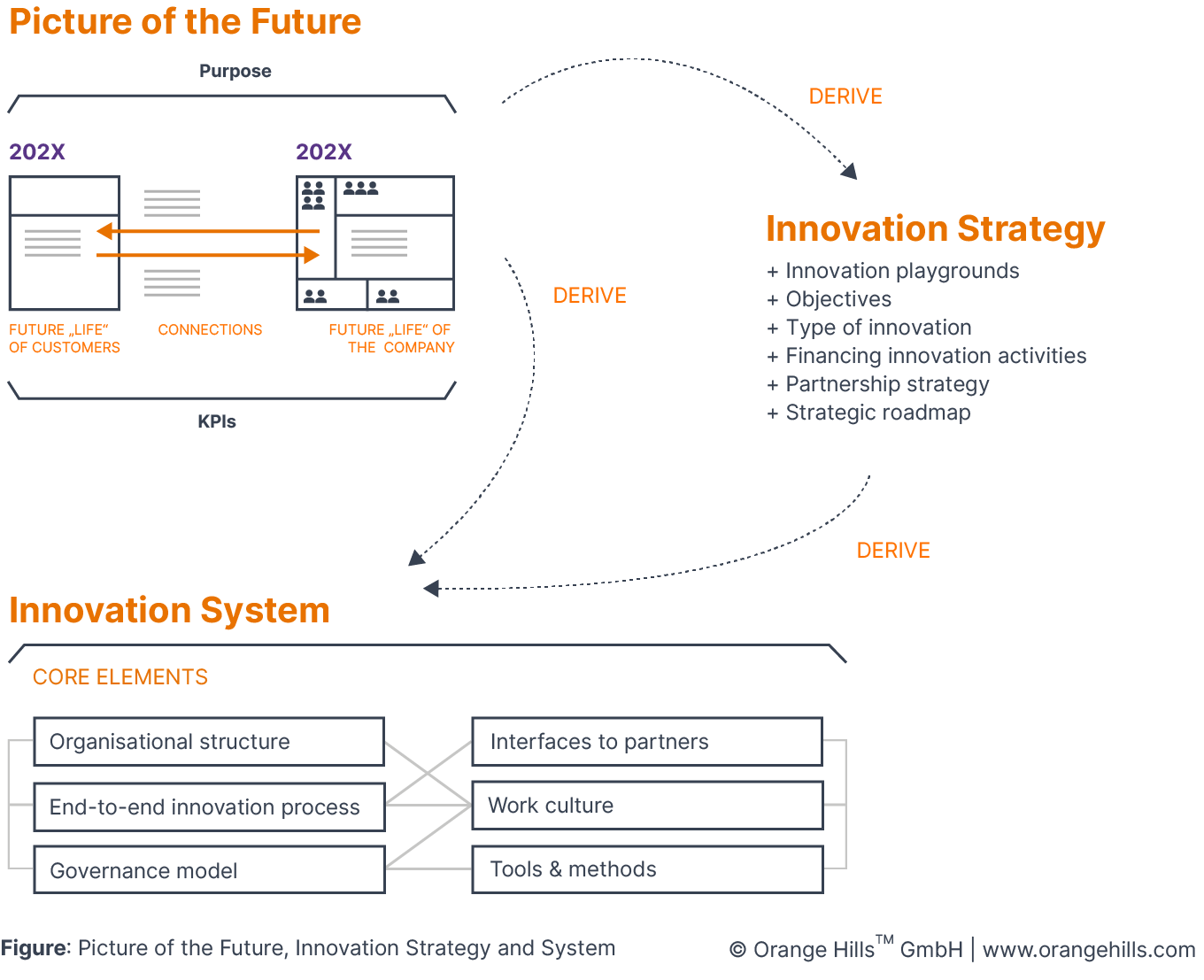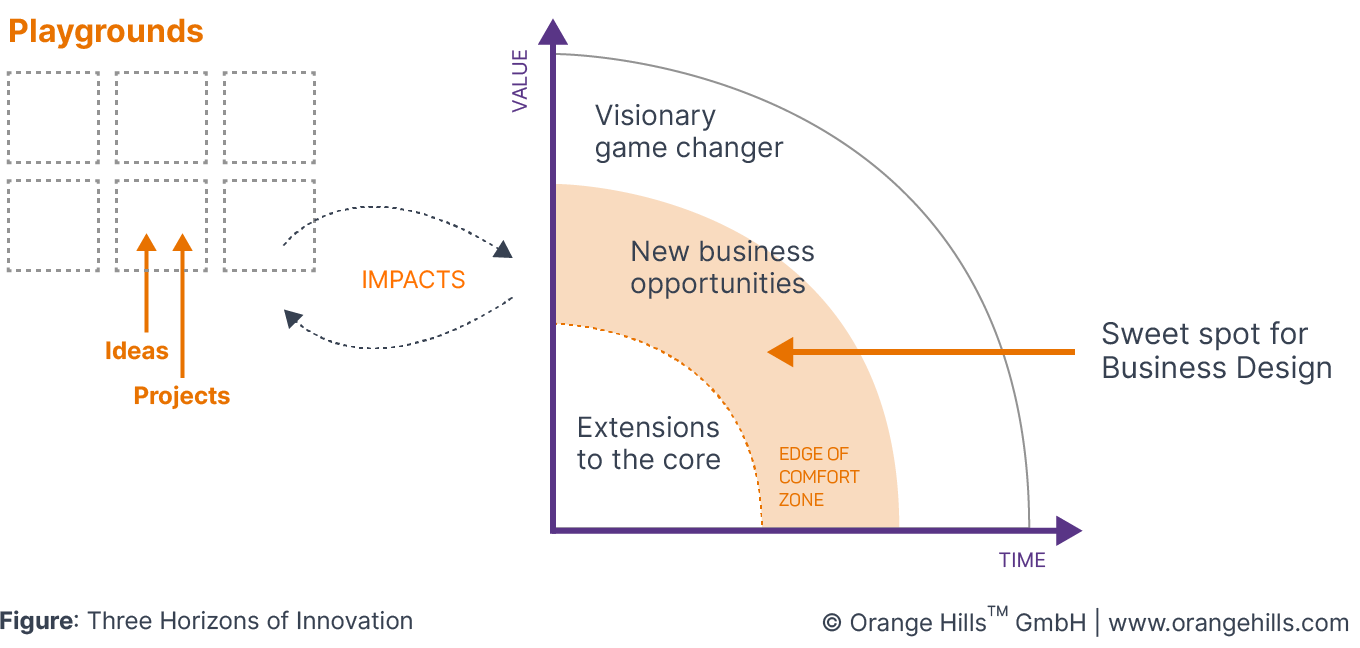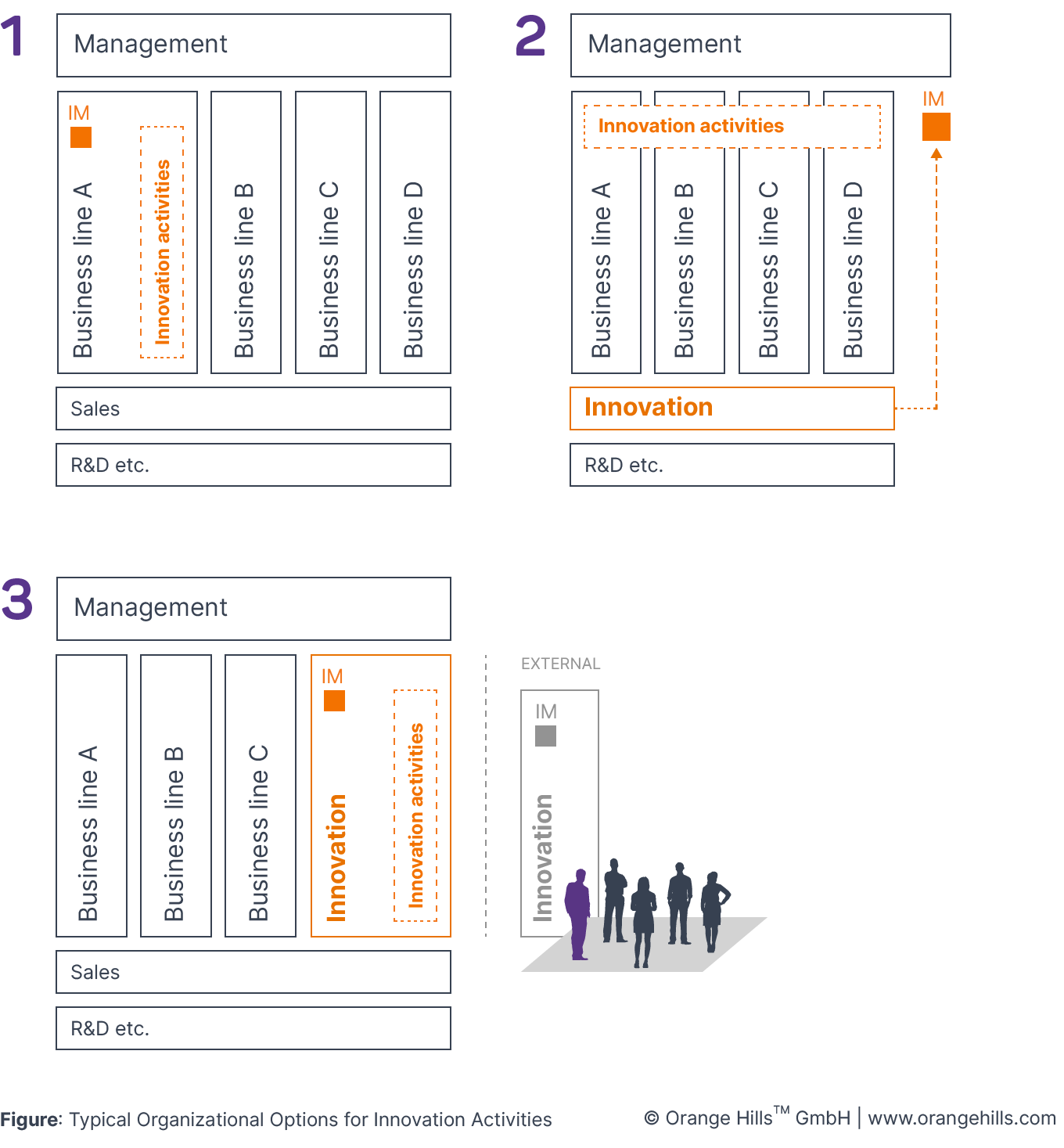Management System for Business Design
This chapter has been published for corporate innovation managers who want to establish a modern innovation management system around the Business Design approach. Here we stress more strategic and organisational topics such as the design of a "Picture of the Future", end-to-end innovation processes, organisational structures and stakeholder management. Many of these topics, however, are prerequisites for the success of Business Design projects.
Bernhard Doll
Business Design Maverick
1. Introduction
Business Design is an essential part of a modern innovation management system and bridges the gap between ideas for new products, services or business models and the first revenue on the market. Thus, there are more pieces of the puzzle to form an entire innovation management system. Before you build your innovation management system, please consider the following questions. Every element of the system including organisational structure, your end-to-end innovation process as well as governance processes including, decision-making, budgeting and reporting will depend on your answers to these three questions:
What does your "Picture of the Future" look like?
What is your innovation strategy to reach your "Picture of the Future"?
What management system do we need to implement the innovation strategy?

2. Picture of the Future
Every effective and efficient innovation management system requires an entrepreneurial idea as a "Picture of the Future" for both your organisation and your customers. If your vision of the future is vague, pretty much everything you do in managing innovation will be difficult. See here why.
3. Innovation Strategy
An innovation strategy has many aspects you need to think of. We briefly discuss four key components:
Innovation playgrounds
Innovation playgrounds are rough framings of "spaces" you would like to dig into to generate new ideas for your innovation portfolio. These spaces are derived from a "Picture of the Future" and define a more focused area for research and ideation. Examples can be new technological capabilities, such as "AI for customer profiling" or new product categories such as "new products and services for home care" or new customer segments "digital natives in the modern world of banking". Each playground can be also complemented with economic details around market size, dynamics, competitive landscape, innovation history as well as influencing macro and micro trends etc.
Objectives
It seems obvious that every innovation management system needs a way to measure success. In 9 out 10 systems we see that objectives for innovation are neither clear nor applicable for the specific context of innovation management. Typical financial performance indicators such as revenue, profit, market share etc. are rarely usable in early phases of innovation processes. Each phase of an End-to-End Innovation Process requires its own set of objectives and OKRs. Please find some inspiration regarding framing your objectives here.
Type of Innovation
The definition of the term "innovation" is another essential exercise before you kick-off your first projects in your innovation management system. What "horizon" and what "category" of innovation do you want to target within your innovation playgrounds? We define these three horizons as follows:
Horizon 1: Extension to the core: Revision or extension of an existing product, service, software or business model for the same target group. Can be new features of products or services (for current customers) or process improvements ranging from strengthening the brand perception, sales support or even efficiency gains.
Horizon 2: New business opportunity: New product, service, software or business model with no logic predecessor within an organisation, serving today’s and /or new customers from the same position in the value chain. Here, we usually deal with significant uncertainties at the edge of the comfort zone, which is why the Business Design Process can play out its strengths.
Horizon 3: Visionary game changer: New product, service, software or business model with no logic predecessor within the organisation, serving new customers from a different position in the value chain. Ideas here have the potential to disrupt today's businesses or create totally new markets. Complexity, ambiguity and uncertainties are our key enemies but the upside potential is just huge.

And, as already mentioned, we also distinguish between the innovation categories product, service, software business model and (even) process innovation.
You may ask: Why is "New business opportunities" the "sweet spot for Business Design"?
Well, it is obvious that "Extensions to the core" ideas and projects usually don't require extensive testing and validation on the level of business models, which is why the core strength of Business Design is not fully utilisable. "Visionary game changers" often need a different way of market and trend research and longer project cycles in order to build first products and services. R&D plays a more dominant role here. Nevertheless, in both cases, you can certainly apply elements of Business Design and set up your own innovation management system.
Financing Innovation Activities
Money rules your innovation game! The sources for financial means that fuel your innovation activities is one of the most important decision you make when building innovation management systems. Many options are possible:
Funding by business lines: Business lines allocate a percentage of their annual budget for innovation activities. This is a good idea if you want to develop innovation that is close to the company's core and the line's business.
Funding by traditional R&D budget: Part of the money the traditional R&D department manages goes directly to Innovation and Business Design activities. Since this approach is relatively easy to organise, the flip side is that R&D managers may dictate the agenda of what happens in the innovation space and focus often too much on technological and feasibility thinking.
Funding by centralised innovation department: A centralised department for innovation has its own budget and finances usually cross-divisional innovation projects. This approach works best for innovation, which is quite "new" but still linked to the organisational core.
Funding by own innovation revenue (P&L): For more established innovation management systems, we often consider own revenues from successful innovation projects as a profound source for re-investing in new innovation projects.
Funding by dedicated "investment fund" as risk capital: Internal (or even external) risk capital is also an important instrument to scale up new business usually in an independent legal entity (aka "Start-up"). This approach is usually considered for more radical ideas far away from a company's core business.
Considering an innovation management system that covers a variety of purposes, there is no "either or" but a combination of financial sources. Choose them wisely!
Budgets for innovation projects can't be allocated in a traditional manner, where business cases and 3-10 years revenue forecasts serve as the justification for investments in innovation. Take the perspective of an investor, who puts money into a reserved bucket (= fund) and invests money into prioritised ideas and project teams that need to pass certain "performance gates" in order to get the next instalment.
OK, and now it is time to think about the concrete setup of your innovation management system:
4. Innovation System
Once you have found answers to the key questions above, it is time to design the core components of a modern innovation management system for Business Design. Well, there are many things to consider, but the basic pillars of such systems encompass the following:
Organisational structure
End-to-end innovation process
Work culture
Governance model
Interfaces to partners (internal / external)
Tools & methods
Organisational Structure
There are many options to define a suitable structure for initiating and managing innovation activities. It depends on the type of innovation you are aiming for to select the right structure for the right purpose. Innovation activities can be organised within business lines (see figure, 1.), across business lines (2.) and in a dedicated and centralised organisational unit (3.) - internal or external. This unit can have its own P&L responsibility or act as a pure cost center.

Well, there is no natural law, which organisational structure fits best to design what type of innovation. However, building such system in real one has taught us the following:
Option | Type of innovation |
1 | Best fit to design "extensions to the core" innovation for a business line |
2 | Best fit to design "new business opportunities" for existing customers the company knows quite well |
3 |
|
Another important stream worth mentioning here is externalised / "outsourced" innovation management through independent project teams, acquisition or partnering with start-ups and other partners. This approach usually works in parallel to internal activities, but needs clearly defined touch points with the organisation. With Business Design we focus predominantly on both internal and external innovation processes and love to explore the best setup for specific innovation tasks.
Internalised innovation:
Project teams are staffed with internal employees who invest dedicated time and effort into projects and activities. The benefit of this setup is simplified access to the organisation's resources. But it is also worth mentioning that really new ideas won't grow necessarily out of a legacy culture. Existing power and work structures and a culture tailored around continued optimisation rather than exploration is rarely a hotbed for innovation.Externalised innovation:
Project teams are situated "outside" of a company and are staffed with internal and / or external experts that establish their own independent structures to create new ideas. Independence comes in two flavours here: Firstly, the team is not impeded by bureaucratic processes but, secondly, may also have difficult times to get resources of the mothership (which are often required = unfair advantage) such as access to the customer base.
End-to-End Innovation Process
Since Business Design is specialised on the early phases of the fuzzy front-end of innovation, innovation management systems need to cover the complete journey from research all the way to managing and scaling new business on the market. Thus, there are other activities going on before Business Design and after to roll out and scale new business. We usually include activities around Research & Development, Ideation as well as Go-to-Market (see figure).
Work Culture
And finally, the probably most challenging part of any innovation management system is the work culture. What kind of expected behaviour (= culture) do you want to establish within your system? The variety of aspects you may include here is overwhelming. Please find here some examples what aspects of an innovation work culture can be described.
The implementation of an innovation management system for Business Design usually requires things that are brand new to the organisation, even in contrast to what many employees think and do today. It takes some time to change mindsets and behaviours of people. There are clear limits the way we speed up this transformation process.
Governance Model
A governance model defines all administrative processes required to smoothly run the innovation management system within corporate structures. Every organisation has its own requirements here. The most basic aspects of governance, however, are decision-making and reporting:
Decision-making
Decision-making in innovation management systems happens on various levels: First, a project team needs to be empowered to make their own decisions within a project. Second, new ideas and innovation projects or activities in general need to be planned, evaluated and approved. And last but not least, every modern innovation management process features a series of decision gates along the way to approve next steps. Theses gates need to be described and communicated within the organisation to provide clarity. The following actors are usually considered for decision-making:
Project team: Makes decision on a daily basis on how to proceed in a specific project with less strategic relevance for the entire project.
Project sponsor: Steers the direction of a project to meet his / her entrepreneurial ambition. The project team keeps its sponsor always "in the loop" with Sponsor's Sneak Previews and clear decision gates (e.g. Decide Workshop).
Innovation committee: In many organisations, innovation projects are usually initiated, (continuously) evaluated and approved by a group of managers that is responsible for the orchestration of the entire innovation management system.
Top Management: And finally the C-level management of a company is the important driver to provide and promote the overall vision for innovation management in form of a "Picture of the Future" and a corresponding strategy. It is the job of the management to decide what this "picture" looks like.
Reporting
Reporting seems to be quite boring for many people. However, for innovation management systems, professional reporting processes are important for various reasons:
Decisions in innovation management systems should be made based on facts and not gut feelings. A decisive and clear reporting on what is going on is key for the management to make good decisions.
Innovation activities often trigger people's fear and other emotions that might result in irrational decisions that can kill innovation projects. Reporting can mitigate these emotions by shedding light into the black box of a "scary" project.
Reporting is also a special type of documentation of a project's progress and a tool for regular reflections. Think of reporting as a "diary" that may force a project team to reflect their work and their progress to improve their way of working.
